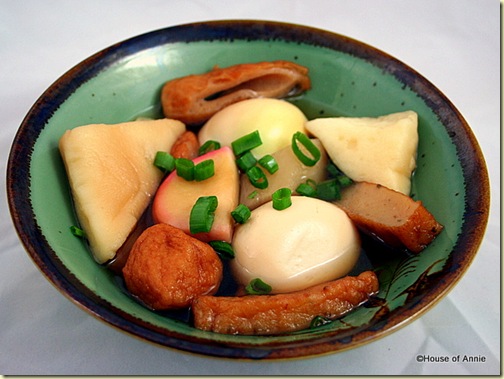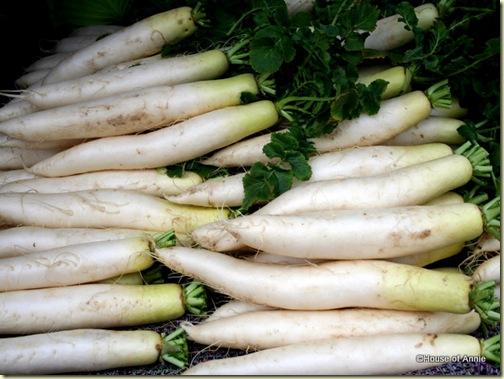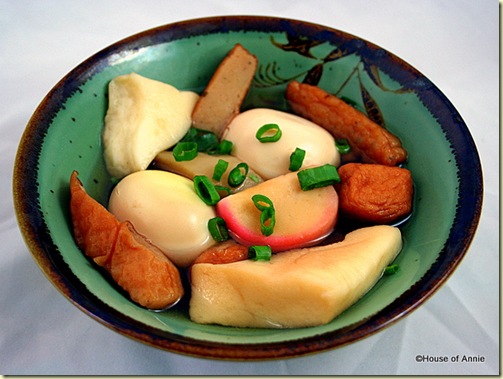Easter is now behind us and we were left with lots of boiled eggs to deal with. This is what happens when you have kids and neighbor’s with kids and we end up coloring a lot of boiled eggs and then in order not to waste them, we have to find ways to eat them all up without resorting to devilled eggs or egg salad sandwiches.
Too Many Easter Eggs
This past Monday, I came up with two ideas—Oden and Thai Son-in-law Eggs. I’ll post about the latter in a future post but for today, let me talk about Oden. Oden is one of those Japanese dishes that I learned while studying in Hawaii (I tell you, that international dorm has been more successful in giving me numerous culinary experiences than actual studying experiences!).
Japanese Oden
Some Japanese students at the dorm made Oden and shared it with me. I loved it and have since recreated it myself several times. Oden is a really simple dish that is perfect when the weather is still cold and you’re not feeling like anything too heavy.
The base stock is a dashi made with kombu and bonito flakes. I’ve cheated by using the Japanese Hon Dashi (Bonito Fish Soup Stock) when I’m in a hurry. Depending on your needs, feel free to make the stock from scratch or use the Hon Dashi (which is what I did this time around). If you have access to an Asian/Japanese grocery store, you could even get a pack of oden soup base mix and then your work is made even simpler.
Build on the Base
The rest of the ingredients is a mixture of daikon, boiled eggs, and different types of fishcakes. Some recipes call for the addition of konnyaku (konjac gelatin) and potatoes. That is the beauty of oden—it allows for a mixture of ingredients based on what you like.
I LOVE fishcakes of all sorts and I love going to the Japanese store and browsing all their different fishcakes and choosing the ones I want to put into my oden. One of the fishcakes I discovered that I absolutely love is called hanpen. If you can find this, you have to try it. It’s a very soft fishcake that comes in a block and that you cut into triangles to add to the soup stock. It expands quite a bit as you simmer the soup. The texture is pillowy soft and airy. It’s a textural wonder and very different from any other fishcake I’ve ever had. I always try to put that in when I can.
The only other ingredients besides the fishcakes that I feel are necessary are the daikon and boiled eggs.
Japanese Daikon Radish
I sometimes add the konnyaku for the textural component it lends but decided against it this time. And if you can get it, do get some of the seasoned yellow Japanese mustard to eat with it. They sell them at Asian grocery stores right next to the wasabi tubes—same brand, different colored mustards.
Once you’ve boiled it for a while, serve it with rice and fight for the fishcakes and ingredients you like best!
Japanese Oden
serves 6-8
Ingredients:
1 lb daikon (about 3 medium sized ones), cut into 3/4 inch rounds or if really big, halved and then cut into 1 inch half moons.
6 hard-boiled eggs, shelled
4-5 packages of assorted fishcakes (I like to get one packet of hanpen, one kamaboko, sliced, some fried fishballs and various other shaped ones)
1 package of konnyaku (cut into 8 triangles or if you want to be fancy, cut into flat rectangles, then cut a slit in the center and turn over to form ribbon pattern)*
6 small potatoes, halved*
7 cups dashi (make your own or use 7 cups water and 1 tsp hon dashi)
1/3 cup soy sauce, or to taste
1/4 cup mirin, or to taste
1 Tbsp sugar, or to taste
Hot yellow mustard paste
*optional ingredients
Method
1. In a large pot, heat dashi, soy sauce, mirin and sugar over high heat. Add daikon. Bring stock to boil then turn down to low and simmer for 30 minutes.
2. Add the rest of the ingredients, except the mustard, and simmer partially covered for about 2-3 hours. Add more water if necessary. Don’t allow the broth to reduce by more than half.
3. Taste the broth and if needed, adjust seasonings by adding more soy sauce, mirin or sugar as needed. The flavors should be lightly salty-sweet.
4. Serve the oden in bowls alongside rice and the mustard paste.
Japanese Oden
Enjoy!
Cheers, Annie




>That is a great idea. I too had tons of eggs lying around, but I resorted to deviled eggs. I’ll keep this in mind for next year.
>that recipe looks incredible. thanks for sharing, annie!
>Hello from Santa Barbara! What a beautiful & delicious solution to all those left over eggs. We will do this and think of you. We love your posts and will always pop in to see the new ones. best, s
>What beautifully done colored Easter eggs! And the dish sounds like a great way to use them up.
>Ooo, love that oden, one of the traditional dishes that we have to have to mark the New Year. We use home-made fish cakes and the best bamdoo shoots that we can find to add to the base. We also use burdock and coltsfoot in some of the oden.
>Mmm yum I love oden on a cold day. Great idea for using up easter eggs:-)
>@all – thanks for your comments!
@judyfoodie – deviled eggs are good, but you get tired of them year after year.
@s. stockwell – thanks!
@Robert – what does “coltsfoot” look like?
>It is called fuki in Japan. It looks like a small round relative of celery, about 1/2″ diameter and usually a couple of inches long. The flavor is not the same.
>I so enjoy Japanese soups and this looks a soup full of goodness
>this is fabulous. this is my favorite soup and have been looking for a recipe for it. thanks for sharing!
>This was SO GOOD. thank you!
>@Robert – thanks again.
@Shayne – lots and lots of goodness 😉
@ushhsu – please do let us know how it turns out for you!
@Terri – you’re more than welcome! Thanks for the feedback.
>Thanks for the oden soup recipe. Last summer I ate them at a party and has been looking for an authentic recipe ever since. Now I will be able to make them myself. Thanks again.
>@rumela – welcome to our blog! Hope you like making the recipe!